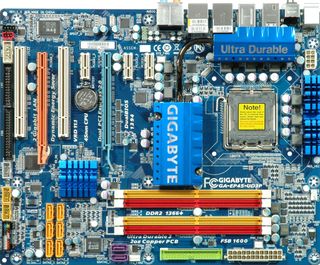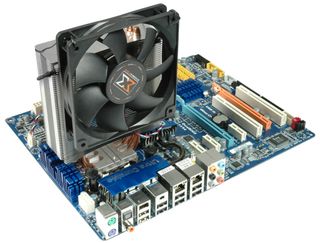Ultra Durable 3: Extra Copper, Benchmarked
Gigabyte EP45-UD3P Ultra Durable 3
Motherboard Revision : 1.0 BIOS Version : F5

We received an EP45-UD3P motherboard from Gigabyte to perform our testing and decided to compare it with several other P45 chipset motherboards that went though our test lab in an effort to analyze their power-saving mechanisms. Gigabyte claims that the Ultra Durable 3 technology introduces power savings while reducing motherboard operating temperature. Let’s see whether or not this is true.
Gigabyte currently has nine different P45 motherboards that all incorporate the Ultra Durable 3 technology for Socket LGA775. We’re not sure that it makes sense to offer so many motherboards that often differ just by nuances, but there are models for DDR2, DDR3, for enthusiasts, for mainstream systems and even for low-budget users. Ultra Durable 3 is also available on at least one X58 motherboard for the Core i7 processor and Socket LGA-1366. According to Gigabyte, the thickness of the ground and power layers increased from 35 µm to 70 µm due to the greater amount of copper. The board comes with a reasonable amount of voltage regulators: there are six MOSFET components, equaling six phases that the DES feature is capable of switching on and off according to processor power requirements.
Features

The EP45-UD3P is a board designed for the upper-mainstream, and comes with a large number of features. These include dual Gigabit Ethernet ports, 6+2 SATA ports (two eSATA ports for external drives) with RAID 0/1/1+0/5 support, eight USB 2.0 ports at the back panel, Firewire 1394a and a TPM chip (Trusted Platform Module), two x16 PCI Express 2.0 slots for ATI CrossFire support (one slot running 16 lanes, the other running eight lanes) and finally, support for DDR2 speeds above DDR2-1200. Gigabyte says that Ultra Durable 3 is also responsible for reaching DDR2-1366 speed, which is typically hard to achieve with most memory.
The audio solution is HD compliant, and is based on a Realtek ALC889A codec with optical and coaxial digital outputs. Gigabyte’s two additional SATA/300 ports are provided by a dedicated storage controller, which also provides an UltraATA/133 channel for two legacy storage devices. Last but not least there is even a floppy controller on the motherboard to allow installing a 3.5” FDD.
Results?
Stay on the Cutting Edge
Join the experts who read Tom's Hardware for the inside track on enthusiast PC tech news — and have for over 25 years. We'll send breaking news and in-depth reviews of CPUs, GPUs, AI, maker hardware and more straight to your inbox.
We used a Core 2 Duo E7200 as well as a Core 2 Extreme QX6850 for testing. Using the efficient Core 2 Duo E7200, we found that the new EP45-UD3P introduces slight power savings when the DES feature is enabled, but the power savings were minor: 1.7% at peak load, 2.25% at idle compared to DES switched off, but Intel SpeedStep switched on. The average power requirements during a SYSmark 2007 Preview run and during idle were in line with the other motherboards, but slightly higher than on a Gigabyte EP45-DS3R, which is a comparable motherboard without the Ultra Durable 3 feature. The performance per watt score we achieved was also in line with the regular motherboard.
There is a Temperature Decrease

We measured lower PCB temperature, but the improvement is not as substantial as Gigabyte says. The manufacturer says that the Ultra Durable 3 motherboards can reduce operating power by 50°C, and we cannot confirm this. We tried an overclocked Core 2 Extreme QX6850 at 3.33 GHz at 1.4 V to find differences between the EP45-DS3R and the new EP45-UD3P. Since we did not have an infrared camera, we decided to measure the PCB temperature at the lower side of the motherboard in the entire area around the CPU socket and the voltage regulators. We used the lower side because it would not be affected by the CPU cooler or related air flow.
The temperature difference between the DS3R board and the UD3P with Ultra Durable 3 technology was 21°C after running Prime95 for a period of 30 minutes. We found the highest temperature readings of 90°C on the EP45-DS3R in the area of the voltage regulators, and we measured 69°C for the EP45-UD3P. Obviously, there is quite a noticeable difference. However, the difference is largely affected by the fact that the Ultra Durable 3 motherboard has voltage regulator heat sinks, which the conventional DS3R does not have them. After removing the heat sinks, the maximum temperature increased to 86°C, leaving a mere 4°C benefit to the Ultra Durable 3 board.




Current page: Gigabyte EP45-UD3P Ultra Durable 3
Prev Page Ultra Durable 3: How It Works Next Page Test Procedure And Test SetupMost Popular

